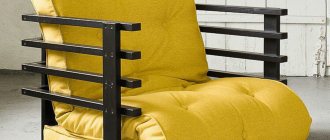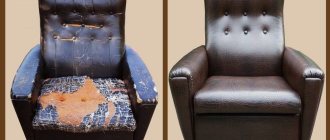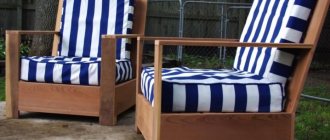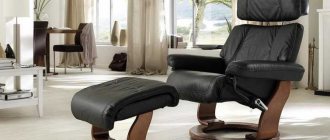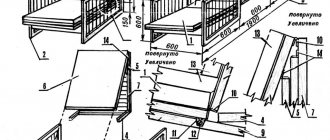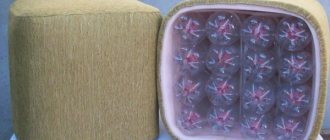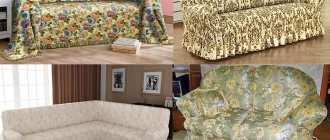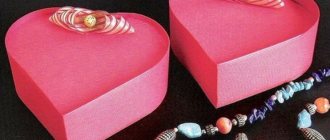Oct 28, 2020
Upholstered furniture is the basis for creating a cozy and homely atmosphere in any room. But no matter how much proper care is taken for such furniture, over time the upholstery still wears out and loses its visual appeal. The same thing happens with a computer chair - every day it does a good deed for its owner, which is why it gets worn out and quickly loses its original appearance. Owners definitely want to extend the life of their favorite furniture as long as possible. And although getting rid of scuffs is quite difficult, don’t rush to look for a new chair! To solve this issue, you can sew a cover for a computer chair.
This cover will help you hide the external defects of the chair and add some zest to your office interior. After all, if you create several variations of a product, different colors and materials, you can change them according to your mood. In addition, the cape is easy to remove and wash in case of stains.
In this article, we will look at the key points of sewing furniture covers, determine the most suitable materials, and also give some universal tips, thanks to which even a novice seamstress can quickly sew a cover for an office chair.
Why do you need a cover?
Using a cape will help not only hide defects in the upholstery. The cover will protect the new chair from dirt and damage. This is especially true in homes where there are small children and animals. The cover is easy to remove and wash, unlike the upholstery. In addition, using a cover will help to fit an office chair into almost any interior. A cover for a leather computer chair will make its use more comfortable, especially in the summer.
How to choose and calculate the amount of fabric?
In addition to an attractive appearance, the material for the case must meet a number of criteria:
- density (so that the old upholstery does not show through).
- abrasion resistance (for long-term use).
- ease of cleaning.
The most popular options: flock, chenille, microfiber. They are combined, that is, they combine natural and synthetic fibers. This allows you to achieve high performance characteristics while maintaining the positive properties of natural materials.
The amount of fabric needed to sew a cover for a computer chair depends on the model of the chair and the type of cover: the latter will cover only the upholstery or the entire structure. In the first case, you will need a minimum amount of material, which can be easily calculated by measuring the length, width of the back and seat. To the results you need to add 10 cm for the overlap, 2 cm for the elastic and 1 cm for the hem. That is, the resulting measurements need to be increased in length and width by 26 cm.
If the cover completely covers parts of the computer chair, the amount of fabric will double.
Fabric selection
Before purchasing fabric for a chair cover, you should pay attention to some criteria that will help in your choice, namely:
- Strength. You should only focus on materials with high strength;
- Fabric color. In this case, you can rely on imagination and taste, but it is best to select the shade of the material according to the color scheme of the room’s interior;
- Fabric preparation. Immediately after purchasing, you need to wash and dry the fabric; if this is not done, the sewn cover will shrink during the washing process and will no longer fit the size of the chair.
The product can be attached with an elastic band
Cover-cape
Sewing a cover for a computer chair of this type is very easy; even a beginner can handle the job. The model is suitable for rectangular office chairs, where the back is connected to the seat. The cape will turn out to be one piece, which greatly simplifies the sewing and processing of the product.
To calculate the amount of fabric, you need to take two back lengths, one and a half seat lengths and add 2 cm for the hem. When measuring the width, it is necessary to take into account the thickness of the chair.
A piece of fabric is laid out inside out on a computer chair, folded over the back of the backrest and under the seat. The material is fixed to the upholstery with pins so that it does not move, and is swept or chipped directly on the chair, taking into account the bends. Next, the cover is removed and the seams are sewn. The edges are processed.
To prevent the fabric on the back of the back and under the seat from puffing up, but lying tightly, an elastic band is sewn along the edge.
The cover for the computer chair is ready. Now you can put it on and admire your handiwork.
Preparing to sew covers
The manufacture of the product is preceded by a step-by-step preparation process, which includes:
- choosing a style and developing the design of a future cape;
- selection of the most suitable fabric, taking into account the characteristics of the room and operating requirements;
- preparation of tools and accessories.
Design selection
When choosing a design, you should take into account the general style of the room in which the chair cover will be used, as well as the functional focus. If furniture is to play a leading role in the interior, the mantle is equipped with all kinds of decoration elements so that it immediately catches the eye.
If you want to create a single composition, it is best to make a tight-fitting cover with an elastic band that will more closely resemble upholstery.
For dining chairs, simple cases consisting of straight elements on all sides are most suitable. To decorate, simply equip the cape with ribbons tied into a large bow on the back.
How to choose fabric
Because A cape for upholstered furniture primarily performs a protective function; the fabric for it must have high wear-resistant and moisture-repellent properties, not fade in the sun, and be easy to clean. In addition, the material should be pleasant to the touch. The most common:
- Velours. A budget option that resembles velvet, but is cheaper. It has a synthetic base, due to which it perfectly retains its original characteristics.
- Flock is a soft and delicate material with a velvety surface that has high protective properties. The fabric does not allow moisture to pass through, is easy to clean, and does not lose its original appearance for a long time.
- Cotton is a natural material, so it is best suited for children's furniture. Such a cover may lose its shape after some time due to its susceptibility to shrinkage.
Perfect for sewing a case for a chair are jacquard, microfiber and chenille, which are quite durable, but are more expensive fabrics.
Required Tools
In the process of making capes you will need:
- large sheets of paper or simple fabric for creating patterns or patterns;
- measuring tape for taking precise measurements;
- pencil, marker, chalk or piece of soap for drawing lines on paper and fabric;
- scissors, pins, needles;
- zippers, decorative ribbons and other accessories;
- sewing machine and how to use it.
Sewing a simple cover with elastic bands
This model is suitable for office chairs where the back and seat are separated and have a rounded shape. A stretch cover for a computer chair will fit best if it is made of elastic material.
Work begins by securing a piece of fabric with pins to the seat of the chair. To ensure that the cape lies flat and does not bulge, you need to tighten the material. A piece of chalk is used to trace the perimeter of the part. The workpiece is removed and laid out on a flat surface. The resulting perimeter must be increased by the thickness of the chair seat and added 6 cm for overlap, elastic and processing.
Now all that’s left to do is cut out the blank and make a tunnel for the elastic. If the material crumbles, it is necessary to process the edge with an overlock or zigzag stitch. Next, it is turned up one and a half centimeters and a line is laid. In the part where the seat is attached to the permanent contact, leave 2-3 cm for ease of retracting the elastic. At the final stage, using a safety pin, the elastic band is placed into the formed tunnel, and the edges are tied.
Ready! Now the product can be tried on. The cape on the back is sewn in the same way.
Case with zipper
This model is somewhat more difficult to manufacture, but looks neater due to the darts.
Work begins with creating a pattern for a cover for a computer chair. Unfortunately, there is no universal scheme, because each model of office chair has its own characteristics.
Tracing paper or a piece of unnecessary fabric is fixed on the seat of the chair with pins and traced with a pencil. In the process, folds are formed so that the material lies as tightly and evenly as possible. There will be darts in these places. The resulting perimeter must be increased by 1 cm for seams. The pattern for the upper part of the seat is ready. With the bottom, everything is somewhat more complicated, because you need to provide a hole for attaching the legs, permanent contacts and armrests of the chair.
To do this, copy the pattern of the top of the seat and transfer the location of the parts onto it. The middle of the holes for the armrests is connected with a straight line. They do the same with permanent contact and a chair leg. This created three parts for the bottom of the seat, which will be connected to each other with zippers. The elements need to be divided, leaving a hole for the chair leg, and increased around the perimeter by 1 cm for seams. The pattern for the bottom is ready.
The blank for the backrest is made in a manner similar to the top of the seat. You will need two identical parts.
Now you need to measure the perimeter and thickness of the seat. This will be a stripe running along the edge of the product. It can be made of the same fabric as the main parts, or create contrast. Add 2 cm to the width of the tape for seams. A similar part will be needed for the back of the chair.
So, all the pattern elements are ready. You can proceed to the next stage of work.
Creating a pattern, cutting and calculating fabric consumption
Before you begin the main sewing of the product, you should complete the pattern and cutting. To do this, measure all parts of the chair: the back, armrests, seat, and pillow. You also need to decide on the location of the seams. They can be marked directly on dark fabric or drawn on the upholstery, and then moved to the canvas.
Important! During this work, you should take into account the contour alignment inserts, as well as bends and thickness.
You can sew the cover using the following pattern
To avoid confusion with the sizes, you need to sign them on the wrong side of the parts that have already been cut out. When cutting, it is important to take into account the darts, which allow the cover to fit the chair perfectly without forming folds or lumps. And also do not ignore tucks, folds, frills and hems.
The simplest pattern of a cover for a chair with armrests is made in such a way that, in addition to the seam allowances, there is still twenty centimeters of fabric left, which will be needed to fit the product, bends and overlaps. In the case when some parts of the furniture are made in a non-standard shape, the pattern is drawn in this way: a thin fabric is applied to the silhouette and crimped on each side. And after the measurements are taken, patterns should be developed on graph paper. After this, the patterns must be laid out on the material in such a way that during cutting there is as little unnecessary waste as possible. Afterwards, the patterns are outlined with chalk, taking into account the allowances.
You might be interested in: Features of lubrication of sewing machines from different manufacturers
Cover for wooden chair
Important! The cut parts should be ironed from top to bottom along the grain line for normal straightening of the seam.
Step-by-step instruction
The fabric chosen for sewing a cover for a computer chair with your own hands is laid out inside out on a flat surface and the pattern details are fixed on it with pins. The elements are outlined with chalk and then cut out. The edges of the parts are processed with an overlocker or sewn with a zigzag so that the fabric does not fray.
Next, the elements are swept away and tried on a computer chair. The strip of fabric running along the perimeter must be cut to leave holes for the armrests and permanent contact. At this stage, you can adjust the darts so that the cover lies more evenly. There is no need to sew the parts of the lower part of the seat together; zippers will be sewn in there. Having achieved a perfect fit, the seams are sewn on a machine. Part of the side seam on the back is left free for the zipper.
To make the cover look neater, the seams are folded over the strip running around the perimeter of the chair and an additional stitch is laid. Now they will not bend and puff up.
Now you need to sew a zipper: a long one into the cape for the back (from the permanent contact to the middle of the side part) and three short ones, connecting the parts of the bottom of the seat.
Your hand-sewn computer chair cover is ready. It will look great in the interior and will protect the furniture from dirt and damage.
Using the technology described above, you can sew a cover for a computer chair from old jeans. To make parts for the back and seat, you first need to undo the trousers and connect the parts so that you get a fabric that matches the length and width of the elements of the office chair. This is a simple option.
To make a denim case more original, you can use the patchwork technique. In this case, the strength of the cape will increase.
Useful tips
As you can see, sewing a cover for a computer chair with your own hands is not at all difficult. And the advice from experienced craftswomen collected below will make the process even easier and more enjoyable.
- Before transferring the pattern details onto the fabric, the latter must be washed in accordance with the care instructions. This is necessary so that the material shrinks. If the finished cover shrinks, it will be impossible to pull it onto the chair.
- When laying out the pattern pieces, you need to follow the direction of the weft and warp threads. This way the product will look neater and will not warp after washing.
- In order not to get confused during work, it is recommended to sign the parts of the product with chalk from the inside out.
- Symmetrical pattern elements are folded in half to reveal distortions.
- Inexperienced craftswomen are advised to first try sewing a cover from unnecessary fabric, and only then switch to expensive materials.
Materials and necessary tools
Specialized stores for handicrafts can currently offer a fairly large assortment of goods when choosing textile products. And even the most picky buyers can almost immediately find what they need.
Scheme for making a product for a regular chair
If you need to make a furniture cover, the following alternatives are excellent options:
- Velours. The material is very soft and pleasant to the body. This fabric does not require special care and has hypoallergenic properties;
- Cotton. The most important positive quality of this material is its naturalness. However, it is completely short-lived, since the material does not contain artificial fiber. When washed, cotton may shrink;
- Flock. It is soft and gentle in tactile sensations, however, despite this, it is a fairly durable material, which would be an ideal option for making a chair cover.
You might be interested in Several patterns of toy animals made from fabrics
A cover is a good way to protect a stool.
Having decided on the choice of material, you should prepare the tools that will be necessary for sewing a cover, namely:
- Scissors;
- Simple pencil;
- Sewing machine;
- Needle;
- Tape measure;
- Vacuum cleaner;
- The pins are ordinary;
- Paper pattern;
- Zipper closure.
Stool cover
